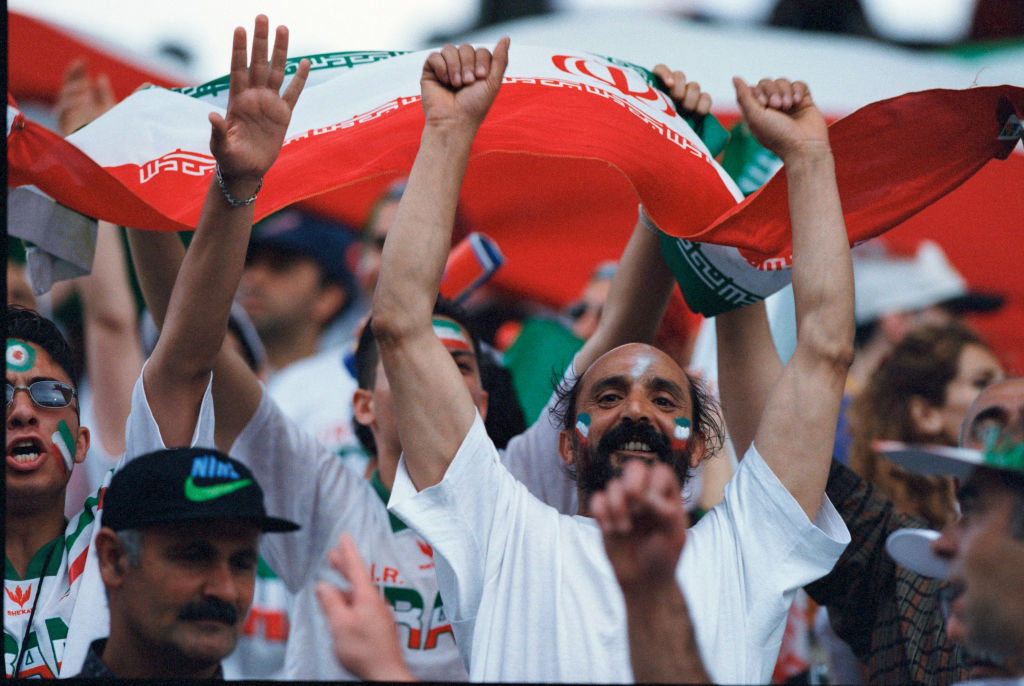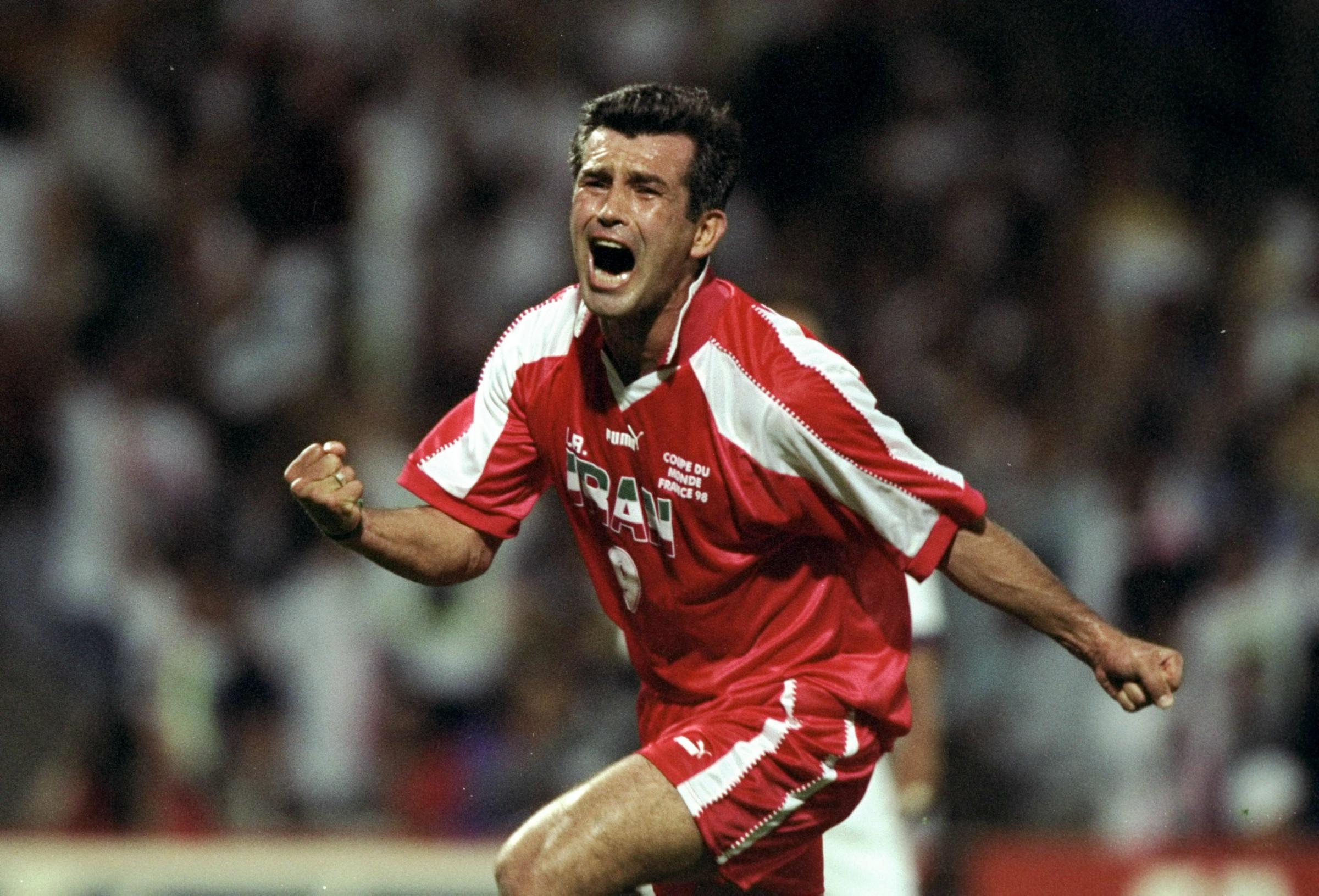
Whenever the U.S. and Iran, two geopolitical rivals who severed formal diplomatic ties in April 1980, meet in any sort of international sporting competition, it’s more than a game. The Group B World Cup match taking place between the two nations in Doha on Nov. 29 is far from an exception.
Mass protests have erupted across Iran since 22-year-old Mahsa Amini died on Sept. 16 while in police custody after she allegedly violated the country’s mandatory hijab laws. At least 445 demonstrators have been killed since the protests began, including 63 children, according to the Tehran-based Human Rights Activists News Agency. Meanwhile, Iran’s World Cup soccer players refused to sing the national anthem, in solidarity with the protestors, before the team’s opening game against England on Nov. 21. (Iran lost that game, 6-2. The players mouthed along to the anthem before the team’s dramatic 2-0 victory over Wales on Nov. 25, days after former national player Voria Ghafouri was arrested for “spreading propaganda;” Ghafouri is a longtime critic of the regime.)
More from TIME
Read More: Team USA’s World Cup Fate Is in Their Own Hands Following Tie With England
In short, the stakes couldn’t be higher. And we haven’t even mentioned the soccer part. After Iran’s victory over Wales and America’s 0-0 draw against England on Black Friday, the U.S. must beat Iran to advance to the knockout stage. With an Iran victory; Iran advances. A draw would put Iran in the Round of 16, if England beats or draws with Wales. For the U.S., failing to make it to the Round of 16 would be another crushing World Cup disappointment, a setback that could quell the team’s momentum going into the 2026 tournament, which it will host along with Mexico and Canada.
It’s simply win or go home.
Iran is looking for a repeat
This marks the second World Cup meeting between the U.S. and Iran. The first, back in 1998 in France, unfolded under very different circumstances. The 1979-80 hostage crisis, in which Iranian students held more than 50 U.S. diplomats and citizens hostage for more than a year, was less of a distant memory. That followed the 1979 revolution that forced longtime U.S. ally and autocrat Mohammad Reza Shah, the last Shah of Iran, into exile: Ayatollah Khomeini came into power declaring Iran an “Islamic Republic.” Intense opposition to the U.S. was a core—and popular—tenet of Khomeini’s theocracy because of historical grievances. That includes the 1953 CIA-backed coup of Iran’s last democratic leader, support for the unpopular Shah in subsequent years, and backing Saddam Hussein’s 1980 invasion of Iran—a war that lasted eight years and left at least an estimated 500,000 dead.
Still, there are some lessons from that first meeting that are useful for today, especially for the Americans. Most pointedly: try to harness the longstanding geopolitical rivalry at play. (Those tensions continue to run high: on Wednesday, Washington levied economic sanctions on three Iranian security officials due to the regime’s crackdown on protests.)
Back in 1998, Team USA went out of its way to downplay the political rivalry with Iran and embraced the strategy of just focusing on the game. Iran then beat the U.S. 2-1 in Lyon, eliminating it from the tournament. The loss was a low-point for American soccer, which seemed on the upswing after the U.S. hosted a successful 1994 World Cup.

All about politics
Zooming in from Qatar a few hours before analyzing the France-Australia Group stage game for a Spanish-language broadcaster, Steve Sampson, the U.S. coach back in 1998, says he’s spent a lot of time over the past 24 years thinking about what he would have done differently going into that Iran game. “We were asked by FIFA, by U.S. Soccer, by the organizing committee in France, to make it about football, and not about politics. And I went along with that,” says Sampson. “In hindsight, I would have made it about politics. A coach’s job is to use any and every tool available to him to prepare his team.”
Sampson notes he was a young coach—41 then—who was inclined to fall in line with institutional wishes rather than go rogue. He resigned after the World Cup, after a 0-3 showing in which the U.S. finished last among 32 teams. If Sampson could do it again, he says, he would have leaned into the geopolitical rivalry—just as the Iranians did. “So many Americans have been hurt so dramatically by the Iranian regime,” says Sampson. “We could have played for them.”
Read More: Weary and Thirsty, World Cup Fans Try to Find Joy at a Complicated Tournament
Strategic differences aside, tensions were running high in the days prior to the game. A week prior to the Jun. 21, 1998 kick-off, French television aired an American movie, Not Without My Daughter, which depicted the harsh conditions of life in Iran. The Iranian embassy announced that “Iran is considering removing its national team from the World Cup in protest against the broadcast of the anti-Iranian film.” Iran’s Supreme Leader Ayatollah Ali Khamenei also threatened to pull Iranian players because he did not want them shaking American hands, as FIFA procedure dictated. But the referee, Urs Meier from Switzerland, proposed a sensible solution. The players instead posed for a group picture at center-field. The Iranians gave the American athletes white roses, a symbol of peace, and both teams exchanged banners.
By the time of kick-off, though, security was ramped up “10-fold,” according to Sampson. A FIFA official said there were 150 armed police officers—”unprecedented for a World Cup match”—on duty. (The enhanced presence was there, in part, because of fears that members of Iranian political opposition group, Mojahedin Khalq, would disrupt the match.)
Iran took a more hawkish approach to the match-up. According to a November article in the journal Middle Eastern Studies, Iranian defender Mohammad Khakpour said that many families of war victims from the 1980-1988 Iran-Iraq conflict reached out to the athletes—detailing at length how significant the match was for them, and begging them to defeat the U.S. “Many families of martyrs are expecting us to win,” forward Khodadad Azizi said before the game.
Meanwhile, Iranian media hammered the U.S. in pre-game coverage. One two-part editorial, for example, in the hardline newspaper Jomhuri-ye Eslami, drummed up national fervor. The piece was headlined “The United States Is Still the Iranian Nation’s Enemy Number One.”
During the match itself, a few early U.S. shots hit the post. In the 40th minute, a beautiful Hamid Estili header gave Iran a 1-0 lead. “It became very, very clear that for Iran, that was much more than a soccer game,” says Fox Sports commentator Alexi Lalas, a defender on the 1998 U.S. team. “They harnessed that in a way that we didn’t.”
Sampson says that his Iran’s coach at the 1998 World Cup, Jalal Talebi, later shared with him that at half-time, Iranian government officials came into the locker room and collected the passports of the players. According to Sampson, Talebi said that officials told the players that “if they didn’t beat the United States, they were not welcome back into Iran, nor were their families welcome to leave Iran.” (Talebi could not be reached for comment; an Iranian soccer official in Qatar did not return TIME’s request for comment.)
Iran essentially put the game away with a goal in the 84th minute. A Brian McBride goal in the 87th minute gave the U.S. one last hope, but it was too late.
After the final whistle, the U.S. team failed to hide its devastation. Sampson and some players cried. “It was a complete fiasco and failure and embarrassment,” says Lalas, who didn’t play the entire tournament.
The New York Times reported after Iran’s win that “in Teheran, thousands of celebrating fans took to the streets, some women without their scarves.” Supreme Leader Ayatollah Ali Khamenei was exultant. “This unique struggle is what has given victory and glory to our nation in the course of the revolution, throughout the years of holy defense, and in all of the Iranian nation’s conflicts with the Great Satan,” he said after the game.
On the line
Going into this final Group stage game against Iran on Tuesday, it would be difficult for the American players to view their Iranian counterparts as political enemies. After all, they have signaled opposition to Iran’s repressive regime. Yehuda Blanga, a professor at Israel’s Bar-llan University who co-wrote the Middle Eastern Studies article, says that while most Iranian players supported their government in 1998, that’s not the case this time around.
Sampson advises his coaching counterpart all these years later, Gregg Berhalter, to acknowledge both this historical rivalry and the protest movement going on in Iran. But at the same time, he says Berhalter can’t show too much deference to the opposition. “Don’t buy into the sympathy piece,” says Sampson. “It’s real, and we appreciate that. Just focus on coming fully prepared to do the business on the field.”
In other words, the U.S. can take a cue from England, a team that has put progressive values front and center but dominated Iran on the pitch. If the past is any guide, football diplomacy might only end in tears in a losing World Cup locker room, wondering what could have been.
More Must-Reads from TIME
- Breaking Down the 2024 Election Calendar
- How Nayib Bukele’s ‘Iron Fist’ Has Transformed El Salvador
- What if Ultra-Processed Foods Aren’t as Bad as You Think?
- How Ukraine Beat Russia in the Battle of the Black Sea
- Long COVID Looks Different in Kids
- How Project 2025 Would Jeopardize Americans’ Health
- What a $129 Frying Pan Says About America’s Eating Habits
- The 32 Most Anticipated Books of Fall 2024
Write to Sean Gregory at sean.gregory@time.com